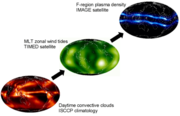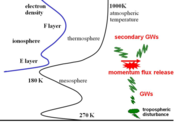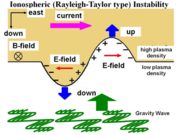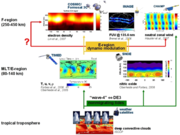Task 4
From CAWSES
Contents
|
What is the geospace response to variable inputs from the lower atmosphere?
Organizational Structure
Task Group leaders: Jens Oberheide (Germany), Kazuo Shiokawa (Japan)
Project 1: How do atmospheric waves connect tropospheric weather with ITM variability? (ITM=Ionosphere-Thermosphere-Mesosphere)
- Project leaders: Mangalathayil A. Abdu. (Brazil) / Jorge Chau (Peru) / William Ward (Canada)
- Project members: U. Achatz (Germany), J. Alexander (USA), A. Arulia (UK), I. Batista (Brazil), E. Becker (Germany), S. Bruinsma (France), B. Clemesha (Brazil), G. Didebulidze (Georgia), J. Forbes (USA), S. England (USA), B. Funke (Spain), D. Fritts (USA), N. Gavrilov (Russia), L. Goncharenko (USA), S. Gurubaran (India), M. Hagan (USA), C. Hall (Norway), P. Hoffmann (Germany), T. Immel (USA), E. Kherani (Brazil), S. Kirkwood (Sweden), P. Koucka Knizova (Czech Republic), T. Li (China), R. Lieberman (USA), C. Lin (Taiwan), G. Liu (USA), H. Liu (Japan), H.-L. Liu (USA), L. Liu (China), M. Lopez-Puertas (Spain), H. Lühr (Germany), A. Manson (Canada), C. Marques Brum (Puerto Rico), C. Martinis (USA), D. Murphy (Australia), T. Nakamura (Japan), D. Pallamraju (India), S. Palo (USA), A. Patra (India), B. Rabiu (Nigeria), T. Ramkumar (India), K. Sato (Japan), L. Scherliess (USA), H. Shinagawa (Japan), E. Talaat (USA), M. Taylor (USA), T. Tsuda (Japan), S. Vadas (USA), W. Wan (China)
Project 2: What is the relation between atmospheric waves and ionospheric instabilities?
- Project leaders: Jon Makela (USA) / Hisao Takahashi (Brazil)
- Project members: I. Batista (Brazil), A. Bhattacharya (India), R. Buriti (Brazil), J. Chau (Peru), D. Fritts (USA), N. Gavrilov (Russia), E. Becker (Germany), L. Goncharenko (USA), J. Guoying (China), C. Haldoupis (Greece), D. Hysell (USA), P. Koucka Knizova (Czech Republic), C. La Hoz (Norway), M. Larsen (USA), H. Lühr (Germany), L.-A. McKinnell (South Africa), A. Manson (Canada), C. Martinis (USA), T. Maruyama (Japan), Y. Otsuka (Japan), D. Pallamraju (India), A. Patra (India), B. Rabiu (Nigeria), T. Ramkumar (India), M. Rietveld (Norway), S. Shamilov (Russia), E. Shume (Brazil), M. Taylor (USA), T. Tsuda (Japan), S. Vadas (USA)
- Project leaders: Dora Pancheva (Bulgaria) / Mamoru Yamamoto (Japan)
- Project members: U. Achatz (Germany), E. Becker (Germany), J. Chau (Peru), B. Clemesha (Brazil), D. Fritts (USA), N. Gavrilov (Russia), L. Goncharenko (USA), J. Guoying (China), S. Gurubaran (India), A. Hertzog (France), P. Hoffmann (Germany), C. Jacobi (Germany), T. Li (China), R. Lieberman (USA), H. Liu (Japan), H.-L. Liu (USA), L. Liu (China), A. Manson (Canada), N. Mitchell (UK), P. Mukhtarov (Bulgaria), D. Murphy (Australia), S. Nozawa (Japan), S. Palo (USA), P. Preusse (Germany), T. Ramkumar (India), M. Rapp (Germany), K. Sato (Japan), C. v. Savigny (Germany), W. Singer (Germany), A. Smith (USA), M. Taylor (USA), T. Tsuda (Japan), B. Vincent (Australia), W. Wan (China), J. Xu (China)
- Project leaders: Hitoshi Fujiwara (Japan) / Mike Kosch (UK)
- Project members: A. Arulia (UK), N. Balan (UK), S. Bruinsma (France), M. Conde (USA), A. Coster (USA), M. Danielides (USA), Y. Deng (USA), P. Dyson (Australia), L. Goncharenko (USA), S. Kirkwood (Sweden), G. Lehmacher (USA), R. Liu (China), W. Singer (Germany), T. Liu (Taiwan), G. Lu (USA), A. Manson (Canada), M. Nicholls (USA), S. Oyama (Japan), A. Richmond (USA), Y. Sahai (Brazil), E. Talaat (USA), M. Taylor (USA), T. Tsugawa (Japan), Q. Wu (USA), H. Yang (China)
- Project leaders: Yukihiro Takahashi (Japan) / Colin Price (Israel) / Earl Williams (USA)
- Project members (tentative): Mitsuteru Sato (Japan), Toru Adachi (Japan), Hiroyo Ohya (Japan), Fuminori Tsuchiya (Japan), Gabriella Satori (Hungary), Umran Inan (USA), Walter Lyons (USA), Steven Cummer (USA), Victor Pasko (USA), Torsten Neubert (Denmark), Elisabeth Blanc (France), Thomas Farges (France), Ute Evert (Netherland), Yoav Yair (Israel), Michi Nishioka (Japan), Masashi Kamogawa (Japan), Yasutaka Hiraki (Japan), Carl-Fredrik Enell (Finland), Alfred Chen (Taiwan), David Smith (USA), Michel Rycroft (UK), Martin Fullekurg (UK), Fernando Saosabbas (Brazil), Enrico A (University of Bologna)
In addition, Task Group 4 has a joint project with Task Group 2 (lead TG2):
Project 6: How does climate change affects atmospheric waves in the ITM?
- Project leaders: TBD (2)
- Project members: TBD
Introduction
A variety of new evidence suggests that tropospheric weather is an important ingredient in geospace variability. Gravity waves generated by hurricanes or typhoons may propagate into the thermosphere and seed ionospheric instabilities, i.e., plasma bubbles, sporadic-E patches and traveling ionospheric disturbances. Atmospheric tides due to persistent tropical rainstorms produce large longitudinal and local time variations in bulk ionosphere-thermosphere-mesosphere (ITM) properties, i.e., temperature, wind, composition, airglow and plasma density, to name a few.
Oscillations of F-region plasma density and other ITM properties at planetary wave periods at least partly reflect the planetary wave activity and variability in the stratosphere. Thermospheric waves generated by high-latitude auroral energy input change the ionospheric and thermospheric environments even at low latitudes. All these waves may further interact with each other and the background atmosphere, i.e., when propagating upward through the stratosphere to the ionosphere, hence producing additional variability and/or secondary waves.
Studying the geospace response to variable inputs and waves from the lower atmosphere is particularly important since the induced variability competes with the solar and magnetic driving from above. Consequences for telecommunications, re-entry and satellite operations still need to be explored. The extent to which the effects of this quiescent atmospheric variability are transmitted to the magnetosphere is yet to be resolved.
The challenge
We thus stand right now at an exciting research frontier: understanding the cause-and-effect chain that connects tropospheric (weather!) and strato-/mesospheric variability with geospace processes. Task Group 4 will therefore elucidate the dynamical coupling from the low and middle atmosphere to the geospace including the upper atmosphere, ionosphere, and magnetosphere, for various frequencies and scales, such as gravity waves, tides, and planetary waves, and for equatorial, middle, and high latitudes. Attacking the problem clearly requires a systems approach involving experimentalists, data analysts and modelers from different communities. For that purpose, the most essential part of Task Group 4 is to encourage interactions between atmospheric scientists and plasma scientists on all occasions.
The scientific issues
The past few years have seen the development of basic ideas about the processes involved, including wave forcing, wave propagation and the neutral-electrodynamical coupling. Satellite and ground-based data sets to attack the problem are now of sufficient length and quality with even more becoming available soon. Mechanistic and first principle modeling results are encouraging and further improvements can be expected. The following list of the scientific issues addressed by Task Group 4 gives a brief summary of what we know and what we do not know so far for (a) gravity waves, (b) tides, (c) planetary waves, and (d) thermospheric waves generated by auroral processes.
Gravity waves
What we know: Gravity waves from convection and jets in the lower atmosphere propagate into the mesosphere, dissipate their energy near the mesopause region, and/or penetrate into the thermosphere.
- Basic knowledge about gravity wave forcing and propagation in the MLT region,
- Theory about penetration of gravity waves into the thermosphere, and
- Speculation about initiation of various ionospheric plasma instabilities by gravity waves.
What we do not know:
- Evidence of gravity wave seeding of ionospheric instabilities, such as
- MSTIDs: wavelength/propagation
- plasma bubbles: day-to-day variability, zonal separation
- sporadic-E patches: scale size and propagation
- How important is gravity wave forcing in the thermosphere/ionosphere dynamics?
Tides
What we know: Nonmigrating (non Sun-synchronous) tides due to deep tropical convection produce large longitudinal and local time variations in bulk ITM properties.
- Temperature, wind, composition, plasma density, electron density perturbations
- 4-peaked longitudinal variations observed by satellites are the DE3 nonmigrating tide
- Basic quantitative knowledge of tidal forcing, propagation and morphology in the MLT region
- Basic qualitative knowledge of coupling into the F-region: E-region dynamo modulation,
due to satellite observations and model simulations since ~2006. Important contributions came from CAWSES-I.
What we do not know:
- What are the tidal structures in the ionosphere-thermoshere (IT), i.e., between 120 km (TIMED) and 400 km (CHAMP, GRACE)?
- What are the temporal variations: days, inter-annual, QBO, solar cycle?
- How much of the tropospheric influence is due to direct tidal upward propagation into the F-region and how much is due to E-region dynamo modulation?
- How important are tides forced by non-linear interactions in the stratospher and/or mesosphere? (for the IT)
- We know little about the coupling between the various waves (tides, GWs, PWs) and mean motions in the IT.
- There is no good understanding of the tidal effects on energy balance, composition, etc…
Planetary waves
Much of the above about tides also applies to the planetary waves. Some specific questions are
- Stratwarm effects on the ionosphere and thermosphere.
- PW signatures in parameters of aeronomic interest, i.e., in O/N2 ratio, nitric oxide, dynamical fields, plasma density?, …
- Wave-wave interactions, interhemispheric coupling.
Thermospheric disturbances generated by auroral processes
What we know: Traveling atmospheric disturbance (TADs) and gravity waves are generated in the high latitude ionosphere due to energy input from the magnetosphere. Related to these aurorally-generated neutral waves, we know
- They are reproduced on global scale by GCM
- We have large-scale views by global GPS-TEC map at middle and low latitudes
- We also have small-scale view by IS radars/SuperDARN radars in the auroral zone
What we do not know:
- How do storm-time neutral waves affect the formation of the equatorial ionization anomaly?
- How is the unusual vertical wind formed in the vicinity of aurora?
- Do thermospheric winds driven by high-latitude ionospheric plasma convection cause feedback to the plasma convection?
- How does the composition change (decrease of O/N2 ratio) of the thermosphere occur and propagate on global scale to cause negative ionospheric storm
Meeting the challenge
Task Group 4 has defined four projects to attack the overarching science questions. This is by no means an exclusive list. Suggestions for new projects are welcome at any time!
Project 1: How do atmospheric waves connect tropospheric weather with ITM variability? (ITM=Ionosphere-Thermosphere-Mesosphere)
- Project leaders: Mangalathayil A. Abdu. (Brazil) / Jorge Chau (Peru) / William Ward (Canada)
- Project members: see Organizational Structure
- CAWSES-I Tidal Campaign will be continued here (with contributions to the other projects)
Project 2: What is the relation between atmospheric waves and ionospheric instabilities?
- Project leaders: Jon Makela (USA) / Hisao Takahashi (Brazil)
- Project members: see Organizational Structure
- Project leaders: Dora Pancheva (Bulgaria) / Mamoru Yamamoto (Japan)
- Project members: see Organizational Structure
- Project leaders: Hitoshi Fujiwara (Japan) / Mike Kosch (UK)
- Project members: see Organizational Structure
- Project leaders: Yukihiro Takahashi (Japan) / Colin Price (Israel) / Earl Williams (USA)
- Project members: see Organizational Structure
In addition, Task Group 4 has a joint project with Task Group 2 (lead TG2):
Project 6: How does climate change affects atmospheric waves in the ITM?
- Project leaders: TBD (2)
- Project members: TBD
Notes:
- All projects are requested to make reports and workshops every 1-2 years in conferences.
- Task Group 4 will organize well focussd sessions at major conferences.
- It is planned to have focused conferences of Task 4 (like PSMOS-DYSMER) every 2 years. Alternatively, there may be multiple-day session at the SCOSTEP STP conferences.
- It is crucial that the different projects interact with each other.
Outcomes and benefits - success criteria
Task Group 4 aims to get significant process understanding, and, to obtain closure towards a better quantitative understanding of the posted science challenge questions. The most important scientific needs towards this ambitious goal are:
Gravity waves
- Penetration of GWs into the thermosphere and ionosphere
- Relation between gravity waves and various ionospheric instabilities
- MSTIDs, plasma bubbles, and E-region patches
- Gravity wave forcing in the thermosphere/ionosphere dynamics?
Tides and planetary waves
- What are the tidal structures and variability in the ionosphere and thermosphere?
- E-region dynamo altitudes, longitudinal and temporal
- How do they affect the thermosphere/exosphere?
- Density, composition, energy balance, ...
- Understand the cause-and-effect chain that couples tropical convection with the F-region (tides)
- Quantitative, first principle modeling; data analysis
- What is the role of tides/GW/PW in plasma bubble seeding?
- Longitudinal and temporal modulation of GW propagation and/or GW-tidal interactions?
- How does climate change affect the tides? (closely related to Task 2)
Thermospheric disturbances and storm-time winds generated by auroral processes
- Ionospheric plasma dynamics at middle and equatorial latitudes by (1) neutral winds from bottom and (2) electric fields from above.
- Which is important for what cases?
- Coupling between thermospheric winds and plasma convection in the high-latitude ionosphere
- Composition change (O/N2 ratio) of the thermosphere. How does it occur and propagate on global scale to cause ionospheric disturbance?
The anticipated better process and quantitative understanding of the underlying physics will allow to assess the relative importance of the lower atmospheric waves to space weather and solar and magnetic driving from above. It will further provide the scientific fundament to explore consequences for key elements of today's technological society, i.e., telecommunications, GPS positioning, and satellite operations.
Existing work and plans
CAWSES Tidal Campaigns
The “CAWSES Tidal Campaign” efforts from CAWSES-I continue (lead: Prof. Dr. William Ward, University of New Brunswick, Canada), as part of Task Group 4. Formally assigned to project 1, it makes contributions to projects 1-3. See [[1]] for further details.
CAWSES India
Provided by D. Pallamraju: With regard to CAWSES-II, I would like to share that the CAWSES-India phase II has also been approved by the Indian Space Research Organization (ISRO) and several research proposals are currently under review. With regard to the Science being pursued, there is a great interest in India in the investigations of the wave phenomena, wave properties and propagations, etc. Especially, plans are underway for investigations during the forthcoming annular solar eclipse, the path of which passes over the dip equator in India. As this would pass over some parts of China as well, focussed investigations can be carried out, especially on the modification of the equatorial dynamics and the modification of the waves thereof. This would be directly relevant to the science being pursued under TG-4. Furhter, there would be a total solar eclipse in the SH on July 11, 2010. In addition to the general observations/investigations, we should probably plan to use these such events to carry out Regional observational campaigns to investigate the (modifications in the) coupling processes in the atmospheres.
ISR campaigns and related activities
Provided by L. Goncharenko: We are planning to have a campaign with incoherent scatter radars this winter as well. This will be ""alert mode"" experiment, i.e. we will be watching stratospheric conditions and issue the alert if stratwarming is predicted. The window is scheduled for Jan 15 - Feb 15, 2010, with 10-days operations. As stratwarming events include many interactions related to Task Group 4 interests, this could be interesting for many people involved in Task Group 4. As many of you operate other types of instruments, I would like to invite you to join in this research opportunity. Please let me know if you want to be informed when experiment begins. So far, planetary wave activity in the stratosphere is very high this winter, with wave 1 approaching all-time highs. We hope it leads to a significant event in the stratosphere.
Provided by A. Arulia: We would also request that Dr Goncharenko keep us informed of the stratospheric warming experiment as we plan to be running EISCAT-FPI experiments in February 2010. The link between space weather and tropospheric weather is of great interest to us. We also run the CMAT-2 model which covers the stratosphere-mesosphere-thermosphere-ionosphere-plasmasphere.
SpreadFEx2 and SAANGRIA
Provided by D. Fritts: (1) a Spread F Experiment 2 (SpreadFEx2) that began in September 2009 and will continue through ~November 2010, including a large suite of instruments in Brazil and Peru, for which I am the coordinator, but there are many international participants in Brazil and the U.S. This would likely fit well in topics 1 and 2. (2) a proposed SAANGRIA (for Southern Andes - ANtarctic peninsula GRavity wave InitiAtive) which is now being proposed as a large airborne and ground-based experiment, with extensive modeling support) employing the NCAR HIAPER research aircraft, and possibly other airborne platforms, for a study of mountain waves from their sources to their dissipation altitudes as high as the MLT. This experiment is now planned for late June to early September 2012. This would seem to contribute most to topics 1 and 3.
A lot of facilities are available related to the Task Group 4 activities, as below.
Instruments and Facilities in Africa
Provided by B. Rabiu: At moment, in Africa, we have 13 GPS facilities (Boston College and AFRL, US) and 13 Magnetometers (MAGDAS, SERC, Kyushu University, Japan) which can be engaged in developing meaning proposal to fit into CAWSES objectives.
Radars
- ESRAD in Kiruna (50 MHz), continuously operating since 1996; MARA in Queen Maud Land (Antarctica) which operates during summer campaigns. Contact: S. Kirkwood (Sweden)
- AMISR –Antarctica, Resolute Bay, Jicamarca, Poker Flat
- PANSY (IS radar in Antarctica) was just approved in Japan.
- EISCAT 3D: phased array antennas, imaging capability, under proposal
- German new type of radar for turbulence and winds in Andoya.
- SuperDARN radars: toward midlatitudes
- US: 6-7 new radars will be installed over next 3 years at Kansas, Azores up to Aleutian islands.
- Russia: four SuperDARN radars will be developed in a next few years
- Australia: Adelaide midlatitude site (part of TIGER network)
- Japan: Second Hokkaido radar is proposed for 2010 construction.
Optical instruments
- FPI at Esrange, Sodankyla, and Longyearbyen (all near EISCAT radars). Red and green line observations. Plans to observe hydroxyl in upper mesosphere. Operation is during nighttime from Sep-April, full 24 hour coverage Dec-Jan in Longyearbyen. Contact: A. Arulia
- OMTIs – airglow imager/interferometer array – extension to lower latitudes
- US Fabry Perot Interferometer – US/Brazil
- Space –borne lidar – next steps?
Satellites
- ESA – SWARM satellite constellation – 3 CHAMP equivalent satellites (anticipated launch 2011)
- ISS – IMAP: launch 2013 (Japanese airglow imager on International Space Station)
- e-POP (Canada): launch 2009, ionospheric outflow
Magnetometers
- MAGDAS – Japan, magnetometer chains on global scale including Africa
- Chinese Meridian Project
VLF receivers
- AWESOME – VLF receivers network
Key linkages
- Priority program “CAWSES” of the German DFG (lead: Prof. Dr. F.-J. Luebken, IAP Kuehlungsborn, Germany), funded until 2011.
- CAWSES India, other national CAWSES projects...
- Cross-task project with Task Group 2 (project 5 above)
- ISSI team 152 (lead: Dr. Peter Hoffmann, IAP Kuehlungsborn, Germany) addressing vertical coupling processes using EISCAT and CAWSES tidal campaign data.
- ISSI (International Space Science Institute, Bern, Switzerland) plans a workshop and subsequent review book publication for a topic of The Energetic and Momentum Coupling between the Earth's Atmospheric and Plasma Environments.
- COSPAR, IAGA, AOGS, CEDAR ….
Milestones
- July 22 (Thu), 2010: TG4 business meeting at COSPAR in Bremen, Germany: 19:00-20:30, room: Arena Foyer / Phobos
- End of August: IAGA CAWSES session and business meetings
- Autumn 2009: ISSI team 152 workshop in Bern, Switzerland
- End of 2009: Project plan
- July 2010: STP-12 conference at Berlin (the week before COSPAR in Bremen, Germany)
- July 2010: COSPAR sessions related to Task Group 4:
- C02 Advances in Remote Sensing of the Middle and Upper Atmosphere and Ionosphere from the Ground and from Space, including Sounding Rockets and Multi-Instrument Studies
- C11 Recent Advances in Equatorial, Low- and Mid-Latitude Mesosphere, Thermosphere and Ionosphere Studies
- C13 Ionosphere -Thermosphere Coupling to Magnetosphere and Solar Wind
- C22 Troposphere to Ionosphere Multi-Scale Wave Coupling Processes
- Autumn 2010: ISSI WS The Energetic and Momentum Coupling between the Earth's Atmospheric and Plasma Environments for review of current and future of topics related to Task Group 4.
- February 2011: Task 4 symposium, part of the IAGA/ICMA workshop on atmosphere-ionosphere coupling in Prague, Czech Republic.
- 2013?: Task 4/CAWSES symposium (TBD)
The next steps
- Work on project plans (end of 2009, project co-leaders)
- Provide input to wiki (end of 2009, project co-leaders)
News, progress reports and business meetings
Latest News/Newsletter
- Date: July 22, 2010
- New TG4 project "How do thunderstorm activities interact with the atmosphere, ionosphere and magnetosphere?" by Yukihiro Takahashi (Japan), Colin Price (Israel) and Earl Williams (USA)
- TG4 business meeting at COSPAR in Bremen, 19:00-21:00, room: Arena Foyer / Phobos, see notes below
- Date: June 8, 2010
- Date: January 6, 2010
- Regional CAWSES-II topical meeting at the Singapore branch of the University of Adelaide during 8-9 March 2010.
- Aim: Discuss results from a number of MF/meteor/VHF and ionospheric radars for studies of MLT dynamics in India, Indonesia, Thailand, China, Korea, Japan, Australia and the Pacific; Plan the coordination of these radars to establish a firm radar network in the Asia-Oceania region.
- Organizers and further information: Ian Reid, University of Adelaide; Toshitaka Tsuda, Kyoto University.
- Date: December 31, 2009
- TG4 team members accepted.
- TG4 mailing lists available
- Date: November 29, 2009
- TG4 team members are being contacted.
- Existing work and plans updated.
- Date: August 29, 2009 at the IAGA meeting in Sopron, Hungary.
- Dave Fritts suggested a new TG4 project that involves coordinated GB and aircraft observations in South America. He's willing to take the lead and will send more info soon. The project was approved by the TG4 co-leaders. Welcome!
- As suggested by Dora Pancheva, TG4 will be included in the atmosphere-ionosphere coupling IAGA/ICMA workshop to be held in Prague, Czech Republic in February 2011.
Business meeting July 2010
- Date: July 22, 2010; at COSPAR in Bremen, 19:00-21:00, room: Arena Foyer / Phobos
- Attendance: about 45 colleagues, including the TG4 co-leaders and project co-leaders
- Agenda
- Brief Overview of Task Group 4 – Oberheide/Shiokawa
- Update of general TG4 activities since the last business meeting (workshop support, newsletter, wiki, mailing list) – Oberheide/Shiokawa
- Summary of the SCOSTEP/CAWSES-II meeting last week in Berlin - Oberheide/Shiokawa
- Project status – project leaders
- New projects – Yukihiro Takahashi (thunderstorms and geospace)
- Future activities, next business meeting, IAGA/ICMA/CAWSES-II/TG4 workshop in Feb 2011
- Other business
- Adjourn
Progress report April 2009 - August 2009
- Date: August 28, 2009
- Report: Jens Oberheide and Kazuo Shiokawa at the CAWSES-II business meeting at the IAGA meeting in Sopron
- Initial "white paper" for wiki finished
- Project 5 (climate change effects on waves) was moved to TG2, but with strong TG2/TG4 interaction
- Project co-leaders have been contacted; 8 accepted (2 per project); need 1 more co-leader (GW expert) for project 1
- Initial draft of potential project team members drafted (needs revision by project co-leaders before contacting team members)
- TG4 business meeting at the IAGA meeting in Sopron, August 2009
Business meeting August 2009
- Date: August 28, 2009; after the CAWSES-II business meeting at the IAGA meeting, from 7pm to 8 pm
- Attendance: about 15 people, including 5 project co-leaders (Drs. Abdu, Pancheva, Takahashi, Makela, Fujiwara) and the 2 TG4 co-leaders
- Overview of TG4 objectives (Oberheide/Shiokawa)
- Projects, co-leaders, structure (Oberheide/Shiokawa)
- It was agreed to ask a colleague from South America to become a co-leader of project 1 (as a GW expert)
- Timelines
- Project plan (project co-leaders, end of 2009 or earlier if possible)
- Input to wiki (project co-leaders, as soon as possible)
- Send list of team members to project co-leaders for revision (Oberheide/Shiokawa, early September)
- Contact team members (Oberheide/Shiokawa, as soon as project co-leaders revisions are received)
- Contact additional co-leader for project 1 (Oberheide, early September)
- Jens Oberheide mentioned that the Global Observing Campaigns on Tides (led by William Ward) will continue. The next campaign will be in winter 2009/10 because of the predicted moderate El Nino.
- Hisao Takahashi and Jon Makela briefly overviewed a plan for project 2: Longitudinal network observation of mesosphere-ionosphere coupling





